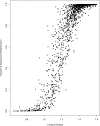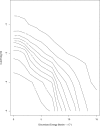The network of sequence flow between protein structures
- PMID: 17596339
- PMCID: PMC1913895
- DOI: 10.1073/pnas.0701393104
The network of sequence flow between protein structures
Abstract
Sequence-structure relationships in proteins are highly asymmetric because many sequences fold into relatively few structures. What is the number of sequences that fold into a particular protein structure? Is it possible to switch between stable protein folds by point mutations? To address these questions, we compute a directed graph of sequences and structures of proteins, which is based on 2,060 experimentally determined protein shapes from the Protein Data Bank. The directed graph is highly connected at native energies with "sinks" that attract many sequences from other folds. The sinks are rich in beta-sheets. The number of sequences that transition between folds is significantly smaller than the number of sequences retained by their fold. The sequence flow into a particular protein shape from other proteins correlates with the number of sequences that matches this shape in empirically determined genomes. Properties of strongly connected components of the graph are correlated with protein length and secondary structure.
Conflict of interest statement
The authors declare no conflict of interest.
Figures





Similar articles
-
Computational exploration of the network of sequence flow between protein structures.Proteins. 2010 Mar;78(4):985-1003. doi: 10.1002/prot.22622. Proteins. 2010. PMID: 19899165 Free PMC article.
-
Super folds, networks, and barriers.Proteins. 2012 Feb;80(2):463-70. doi: 10.1002/prot.23212. Epub 2011 Nov 17. Proteins. 2012. PMID: 22095563 Free PMC article.
-
Filling-in void and sparse regions in protein sequence space by protein-like artificial sequences enables remarkable enhancement in remote homology detection capability.J Mol Biol. 2014 Feb 20;426(4):962-79. doi: 10.1016/j.jmb.2013.11.026. Epub 2013 Dec 4. J Mol Biol. 2014. PMID: 24316367
-
The family feud: do proteins with similar structures fold via the same pathway?Curr Opin Struct Biol. 2005 Feb;15(1):42-9. doi: 10.1016/j.sbi.2005.01.011. Curr Opin Struct Biol. 2005. PMID: 15718132 Review.
-
What can we learn from highly connected beta-rich structures for structural interface design?Methods Mol Biol. 2008;474:235-53. doi: 10.1007/978-1-59745-480-3_12. Methods Mol Biol. 2008. PMID: 19031068 Review.
Cited by
-
A polymetamorphic protein.Protein Sci. 2013 May;22(5):641-9. doi: 10.1002/pro.2248. Epub 2013 Apr 3. Protein Sci. 2013. PMID: 23471712 Free PMC article.
-
On the information expressed in enzyme primary structure: lessons from Ribonuclease A.Mol Divers. 2010 Nov;14(4):673-86. doi: 10.1007/s11030-009-9211-3. Epub 2009 Nov 17. Mol Divers. 2010. PMID: 19921453
-
Comprehensive analysis of sequences of a protein switch.Protein Sci. 2016 Jan;25(1):135-46. doi: 10.1002/pro.2723. Epub 2015 Jul 1. Protein Sci. 2016. PMID: 26073558 Free PMC article.
-
Proteins that switch folds.Curr Opin Struct Biol. 2010 Aug;20(4):482-8. doi: 10.1016/j.sbi.2010.06.002. Epub 2010 Jun 28. Curr Opin Struct Biol. 2010. PMID: 20591649 Free PMC article. Review.
-
Mutational tipping points for switching protein folds and functions.Structure. 2012 Feb 8;20(2):283-91. doi: 10.1016/j.str.2011.11.018. Structure. 2012. PMID: 22325777 Free PMC article.
References
Publication types
MeSH terms
Grants and funding
LinkOut - more resources
Full Text Sources

